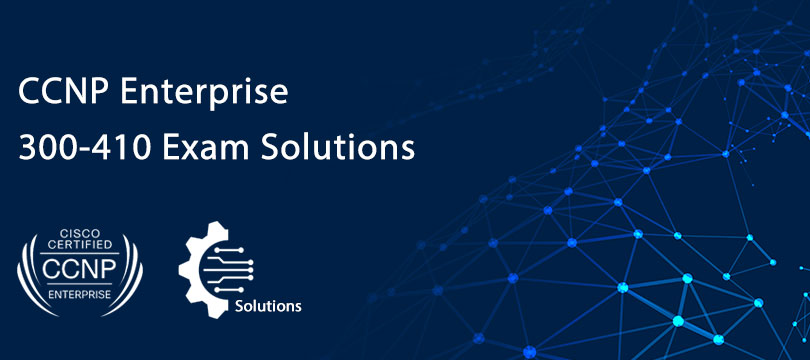
The latest 300-410 Dumps contains 830 exam questions and answers, edited, reviewed, modified, and verified by the Cisco CCNP Enterprise 300-410 professional team, with a guaranteed coverage rate of over 90%, which is the real best exam solution.
leads4pass updates CCNP Enterprise 300-410 Exam Solutions throughout the year! Guaranteed to download the latest 300-410 dumps at any time!
more importantly! Download the CCNP Enterprise 300-410 dumps: https://www.leads4pass.com/300-410.html Enjoy 365 days of free updates!
Moreover, leads4pass 300-410 dumps provide PDF and VCE two learning formats, you can choose according to your own habits! Help you learn easily, 100% pass the CCNP Enterprise 300-410 certification exam.
Sharing some of the latest 300-410 Dumps exam questions
| From | Number of exam questions | Associated certifications | Online Download |
| leads4pass | 15 (Continuously share update latest exam questions and answers) | CCNP Enterprise, CCNP Security, CCNP Data Center … | 300-410 PDF |
Question 1:
Refer to the exhibit
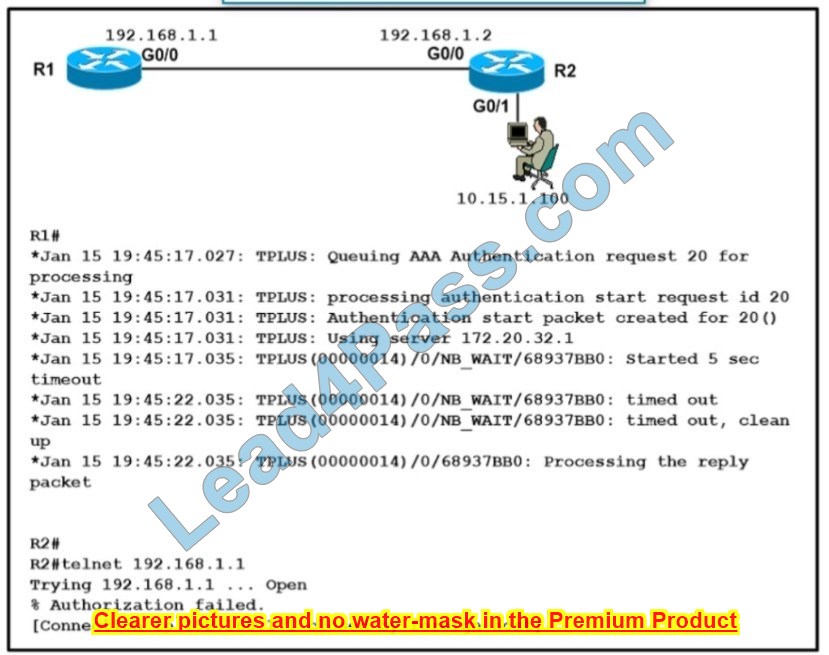
A network engineer is troubleshooting an AAA authentication issue for R1 from R2 When an engineer tries to open a telnet connection to R1 it opens the connection but shows a %Authorization failed error message on the terminal and closes the connection silently Which action resolves the issue?
A. Resolve tacacs+ server host IP authentication miss configuration on the R1 router
B. Resolve tacacs+ server reachability from the R1 router.
C. Configure the tacacs+ server host IP on the R1 router
D. Configure authorization commands in the tactics* server for the R1 router.
Correct Answer: D
Question 2:
Refer to the exhibit.

A network administrator configured an IPv6 access list to allow TCP return traffic only, but it is not working as expected. Which changes resolve this issue?
A. ipv6 access-list inbound permit tcp any syn deny ipv6 any log! interface gi0/0 ipv6 traffic-filter inbound out
B. ipv6 access-list inbound permit tcp any syn deny ipv6 any log! interface gi0/0 ipv6 traffic-filter inbound in
C. ipv6 access-list inbound permit tcp any established deny ipv6 any log! interface gi0/0 ipv6 traffic-filter inbound in
D. ipv6 access-list inbound permit tcp any established deny ipv6 any log! interface gi0/0 ipv6 traffic-filter inbound out
Correct Answer: C
Question 3:
Refer to the exhibit. The administrator successfully logs into R1 but cannot access privileged mode commands. What should be configured to resolve the issue?

A. aaa authorization reverse-access
B. secret Cisco 123! at the end of the username command instead of password cisco123!
C. matching password on vty lines as cisco123!
D. enable secret or enable password commands to enter into privileged mode
Correct Answer: D
Question 4:
What is the total length of an MPLS header?
A. 16 bits
B. 20 bits
C. 28 bits
D. 32 bits
Correct Answer: D
Question 5:
What are the two prerequisites to enable BFD on Cisco routers? (Choose two)
A. A supported IP routing protocol must be configured on the participating routers.
B. OSPF Demand Circuit must run BFD on all participating routers.
C. ICMP must be allowed on all participating routers.
D. UDP port 1985 must be allowed on all participating routers.
E. Cisco Express Forwarding and IP Routing must be enabled on all participating routers.
Correct Answer: CE
Question 6:
There is an issue between two nodes within your network, and you are using Cisco DNA Center Path Trace to help troubleshoot the problem. Which of the following statements are true regarding the Path Trace tool?
A. Overlapping IP addresses are supported.
B. Path trace between a fabric client and a non-fabric client is supported
C. Path trace between a wired client and a wireless client is supported
D. Only TCP traffic is supported.
Correct Answer: C
Question 7:
What must be configured by the network engineer to circumvent the AS_PATH loop prevention mechanism in IP/VPN Hub and Spoke deployment scenarios?
A. Use as-override at the PE_Hub.
B. Use allows-in and as-override at all PEs.
C. Use allows-in and as-override at the PE_Hub.
D. Use allows-in at the PE_Hub.
Correct Answer: A
Question 8:
Refer to the exhibit.
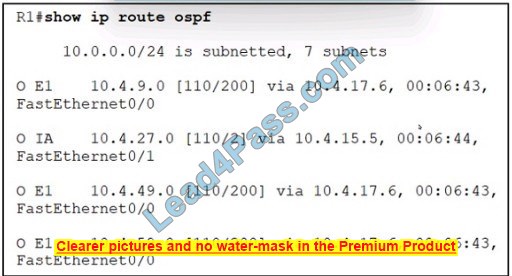
An engineer configured two ASBRs, 10.4.17.6 and 10.4.15.5, in an OSPF network to redistribute identical routes from BGR However, only prefixes from 10.4.17.6 are installed into the routing table on R1. Which action must the engineer take to achieve load sharing for the BGP-originated prefixes?
A. The ASBRs are advertising the redistributed prefixes with the iBGP metric and must be modified to Type 1 on ASBR 10.4.17.6.
B. The ASBRs are advertising the redistributed prefixes with a different admin distance and must be changed to 110 on ASBR 10.4.15.5.
C. The admin distance of the prefixes must be adjusted to 20 on ASBR 10.4.15.5 to advertise prefixes to R1 identically from both ASBRs.
D. The ASBRs are advertising the redistributed prefixes as Type 1 and must be modified to Type 2
Correct Answer: D
Question 9:
Two MPLS routers, R1 and R2, are not directly connected and have an established LDP session running between them. What type of LDP session is this?
A. Remote LDP session
B. Direct LDP session
C. Tunneled LDP session
D. Targeted LDP session
Correct Answer: D
Question 10:
The exhibit contains portions of RouterA\’s BGP configuration and IP routing table.
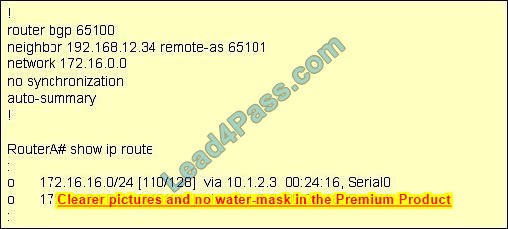
Which IP network addresses, that were not learned using BGP, will be present in BGP advertisements from RouterA?
A. 172.16.0.0/16
B. 172.16.16.0/24
C. 172.16.24.0/20
D. No IGP networks will be advertised because synchronization is disabled.
Correct Answer: A
The auto-summary command can affect which networks, identified by using the network command, will be advertised. Using the existing BGP configuration, the router will not announce the 172.16.16.0/24 subnet.
Instead, it will announce the classful address 172.16.0.0/16 when the IP routing table maintained by the IGP contains any subnet of that classful address.
The network command directly affects what network is advertised in BGP. If the network command does not also include a network mask, and if auto-summary is enabled, the classful address of 172.16.0.0/16 is advertised any time that the router learns about a 172.16.0.0 subnet via its Interior Gateway Protocol (IGP), such as OSPF or EIGRP.
In the exhibit, the routing table does contain entries of the 172.16.16.0/24 and 172.16.24.0/24 subnets that were learned by using the IGP.
If auto-summary is disabled by using the no auto-summary command, only networks in the routing table that are exactly matched to the network commands are advertised. For example, to have the router announce only the 172.16.16.0/24 subnet learned via its IGP, you should alter the network command\’s IP address and include the subnet mask as follows:
network 172.16.16.0 mask 255.255.255.0
A combination of network statements and route statements can be used to advertise a subset of networks that exist. Examine the output shown below:
router bgp 68410
network 192.168.24.0 255.255.252.0
neighbor 172.16.8.5 remote-as 68441
ip route 192.168.24.0 255.255.252.0 null 0
The router is configured to advertise a summary route to the network 192.168.24.0 255.255.252.0. Consider the following networks:
192.168.24.0/24
192.168.25.0/24
192.168.26.0/24
192.168.32.0/24
If this router was connected to those networks, and received a packet destined for 192.168.25.1, it would successfully route the packet because the summary address (where the summarization is the result of the mask 255.255.252.0) is designed to include all of the subnets above except for 192.168.32.0/24.
Therefore, all subnets except 192.168.32.0/24 will be advertised by the network and IP route statements with the summary mask.
Note: Whenever changes are made to a routing policy or to an access list that is used by a routing policy, the change will not be reflected in the routing tables of the receiving routers until the BGP session has been cleared with the clear ip bgp command.
The BGP synchronization rule specifies that networks will not be advertised or used via iBGP unless it also has been learned through an IGP.
If synchronization is disabled, iBGP will advertise a network without also learning it through an IGP.
Objective:
Layer 3 Technologies
Sub-Objective:
Configure and verify eBGP (IPv4 and IPv6 address families)
References:
Cisco IOS Master Command List > a through b > BGP Commands: A through B > auto-summary (BGP) Cisco > Cisco IOS IP Routing: BGP Command Reference > router bgp Cisco > Cisco IOS IP Routing: BGP Command Reference >
network (BGP and multiprotocol BGP)
Question 11:
Which dialer interface command sets the maximum size of IP packets to 1492?
A. router(config-if)# mtu 1492
B. router(config-if)# ip PPP 1492
C. router(config-if)# ip 1492
D. router(config-if)# ip mtu 1492
Correct Answer: D
The correct interface command to set the maximum size of IP packets (maximum transmission unit or MTU size) to 1492 is router(config-if)# ip mtu 1492. This command is required because RFC 2516 states the maximum receive unit (MRU) must not be negotiated larger than 1492 bytes.
All other answers are invalid commands due to incorrect syntax.
Objective:
Network Principles
Sub-Objective:
Explain TCP operations
References:
Cisco > Cisco IOS IP Application Services Command Reference > idle (firewall farm datagram protocol) through ip slb nat pool > ip mtu
Question 12:
Refer to the exhibit. What does the imp-null tag represent in the MPLS VPN cloud?
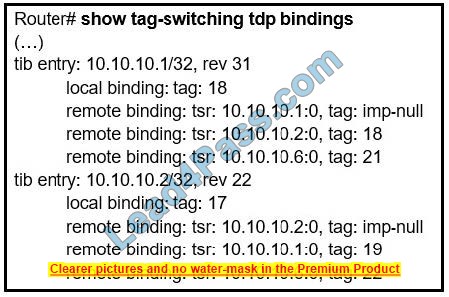
A. Pop the label
B. Impose the label
C. Include the EXP bit
D. Exclude the EXP bit
Correct Answer: A
The imp-null (implicit null) tag instructs the upstream router to pop the tag entry off the tag stack before forwarding the packet. Note: pop means to remove the top MPLS label
Question 13:
DRAG DROP Refer to the exhibit.
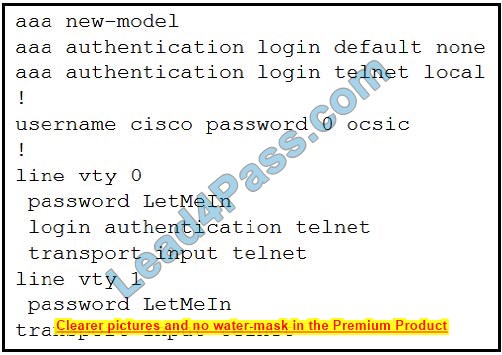
Drag and drop the credentials from the left onto the remote login information on the right to resolve a failed login attempt to vtys. Not all credentials are used.
Select and Place:
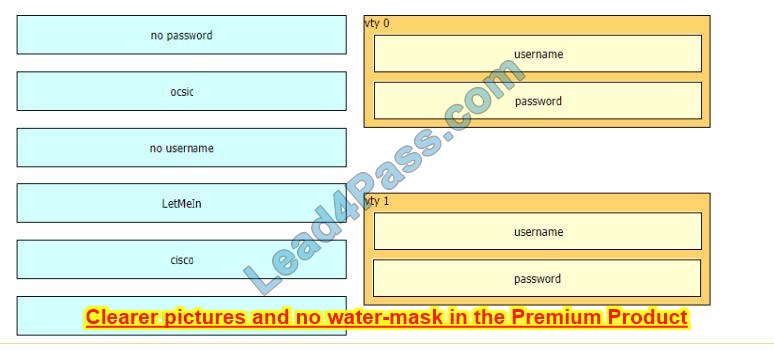
Correct Answer:
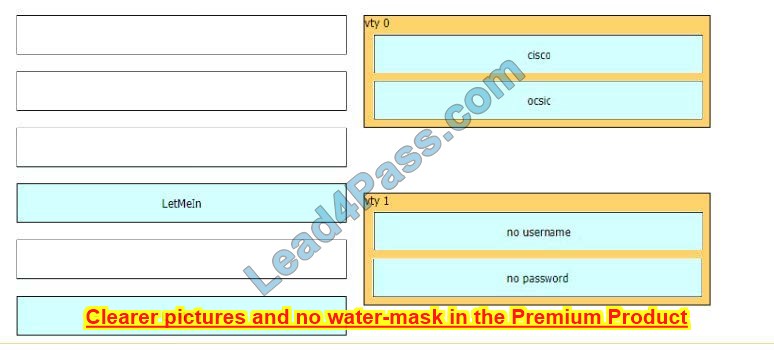
vty 0:
+
cisco
+
0csic
vty 1:
+
no username
+
no password
The command “aaa authentication login default none” means no authentication is required when access to the device via Console/VTY/AUX so if one interface does not specify another login authentication method (via the “login authentication …” command), it will allow to access without requiring username or password.
In this case, VTY 1 does not specify another authentication login method so it will use the default method (which is “none” in this case).
Question 14:
Which control plane process allows the MPLS forwarding state to recover when a secondary RP takes over from a failed primary RP?
A. MP-BGP uses control plane services for label prefix bindings in the MPLS forwarding table
B. LSP uses NSF to recover from disruption *I control plane service
C. FEC uses a control plane service to distribute information between primary and secondary processors
D. LDP uses SSO to recover from disruption in the control plane service
Correct Answer: C
Question 15:
Refer to the exhibit.
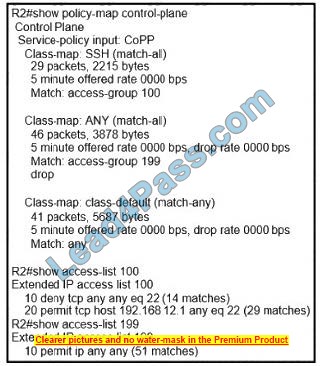
Which action limits the access to R2 from 192.168.12.1?
A. Swap sequence 10 with sequence 20 in access list 100.
B. Modify sequence 20 to permit tcp host 192.168.12.1 eq 22 any to access-list 100
C. Swap sequence 20 with sequence 10 in access-list 100
D. Modify sequence 10 to deny tcp any eq 22 any to access list 100.
Correct Answer: C
| 300-410 dumps update continues to share the latest exam questions | Update time |
| 16-30 | October 2023 |
Question 16:
Which protocol must be secured with MD-5 authentication across the MPLS cloud to prevent hackers from introducing bogus routers?
A. RSVP
B. ALSO
C. LDP
D. MP-BGP
Correct Answer: C
Question 17:
Refer to the exhibit.
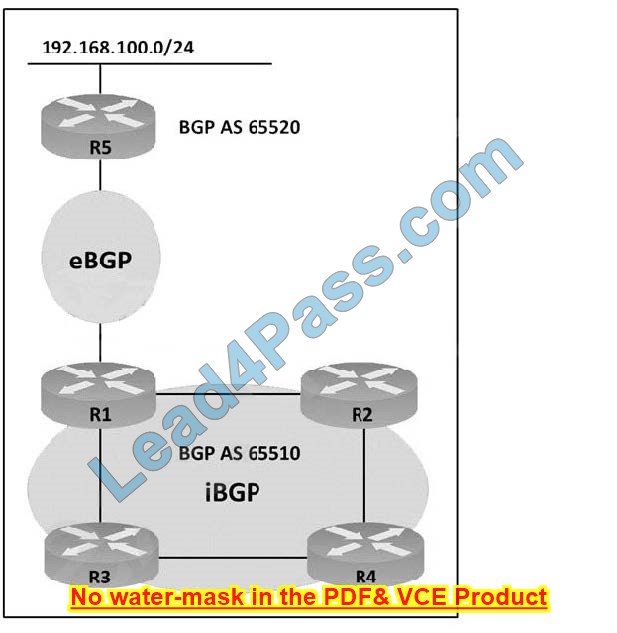
AS65510 BGP is configured for directly connected neighbors. R4 cannot ping or traceroute network 192.168.100.0/24. Which action resolves this issue?
A. Configure R1 as a route reflector server and configure R4 as a route reflector client
B. Configure R4 as a route reflector server and configure R2 and R3 as route reflector clients.
C. Configure R1 as a route reflector server and configure R2 and R3 as route reflector clients.
D. Configure R4 as a route reflector server and configure R1 as a route reflector client.
Correct Answer: D
Question 18:
Refer to the exhibit. An engineer must advertise routes into IPv6 MP-BGP and fail. Which configuration resolves the issue on R1?

A. router bgp 65000 no bgp default ipv4-unicast address-family ipv6 multicast network 2001:DB8::/64
B. router bgp 65000 no bgp default ipv4-unicast address-family ipv6 unicast network 2001:DB8::/64
C. router bgp 64900 no bgp default ipv4-unicast address-family ipv6 multicast neighbor 2001:DB8:7000::2 translate-update ipv6 multicast
D. router bgp 64900 no bgp default ipv4-unicast address-family ipv6 unicast redistribute ospf network 2001:DB9::/64
Correct Answer: B
Question 19:
Automatic 6-to-4 tunnels exist between dual-stack routers (A, B, and C). One router has the IPv6 address, 2002:D030:6BC0:173C::26:37D0/48
Which of the following addresses is the IPv4 address of the router with the IPv6 address 2002:D030:6BC0:173C::26:37D0/48?
A. 10.176.15.131
B. 10.200.80.67
C. 208.48.107.192
D. 208.138.16.110
Correct Answer: C
The IPv4 address of the IPv6 router is 208.48.107.192. In an automatic 6-to-4 tunnel, IPv6 addresses have the 2002::/16 prefix.
The 32-bit IPv4 address of the IPv6 router is then embedded into the IPv6 address. The 32 bits of the IPv4 address are embedded in the second and third quarters of the IPv6 address.
The second and third quarters in the IPv6 address correspond to D030:6BC0. The conversion of these hexadecimal digits into decimal is given as follows:

The IPv6 router does not have 10.176.15.131 as its IPv4 address. The 10.176.15.131 address is the IPv4 equivalent of the second and third quarter (05B0:0F81) in the source IPv6 address.
The other two IPv4 addresses are incorrect as they pertain to neither of the two IPv6 hosts.
Objective:
Network Principles
Sub-Objective:
Recognize proposed changes to the network
References:
Cisco IOS IPv6 Implementation Guide > Implementing Tunneling for IPv6
Question 20:
What statement about route distinguishes in an MPLS network is true?
A. Route distinguishes make a unique VPNv4 address across the MPLS network.
B. Route distinguishers allow multiple instances of a routing table to coexist within the edge router.
C. Route distinguishes are used for label bindings
D. Route distinguishes and defines which prefixes are imported and exported on the edge router
Correct Answer: A
Question 21:
Users report issues with reachability between areas as soon as an engineer configures summary routes between areas in a multiple-area OSPF autonomous system. Which action resolves the issue?
A. Configure the summary-address command on the ABR.
B. Configure the area range command on the ASBR.
C. Configure the summary-address command on the ASBR.
D. Configure the area range command on the ABR.
Correct Answer: D
For OSPF, we can only summarize at the ABR with the command “area range” or at the ASBR with the command “summary-address” -> Therefore answers A and answer B are not correct.
In this question, the most likely problem is that when doing summarization, the network mask is configured wrong, and summarization doesn’t work because of the misconfiguration. When configuring the area range command, make sure that
the summarization mask is in the form of a prefix mask rather than a wildcard mask (that is, 255.255.255.0 instead of 0.0.0.255).
Good reference: https://www.configrouter.com/troubleshooting-route-summarization-ospf-14082/
Question 22:
With respect to modifying an OSPF router ID to a loopback address, which of the following statements are true?
A. OSPF is not as reliable if a loopback interface is configured.
B. Using a loopback address avoids wasting an additional IP address.
C. A loopback interface is not always active, and it can go “down” like a real interface.
D. The loopback address does not automatically appear in the routing table of neighboring OSPF routers, so it cannot be pinged from other routers unless you include it with a network statement on the router local to the loopback interface.
Correct Answer: D
A loopback address does not automatically appear in neighboring routers\’ routing tables, so it cannot be pinged for network troubleshooting.
A workaround for this problem is to add a network statement under OSPF that advertises the loopback address network so that other routers will know how to reach your loopback.
A loopback address is an IP address assigned to a loopback interface, which is a logical interface on a router that behaves like a physical interface. Their advantage is that, unlike physical interfaces, logical interfaces do not go down.
For example:
Router(config)# interface loopback 0
Router(config-if)# ip address 172.17.1.1 255.255.255.0
In the example, a loopback IP address is used by OSPF to provide its router ID. This type of address is preferred because it is assumed to be more stable than a router ID tied to a physical interface. The traditional problem with a router ID
tied to a physical interface is that if the physical interface were to go down, the router would have to change its router ID to some other value. That would cause the OSPF neighbor relationships to reset and change values in the link-state advertisements (LSAs), causing a disruption to the OSPF area.
With this consideration in mind, OSPF is more reliable when using a loopback interface than using a physical interface.
Using a loopback address does not avoid wasting an additional IP address. The address must still be unique.
A loopback interface is always active, and it cannot go “down” as a physical interface can.
Objective:
Layer 3 Technologies
Sub-Objective:
Configure and verify OSPF operations
References:
Cisco > IP Routing: OSPF Configuration Guide > Configuring OSPF > Forcing the Router ID Choice with a Loopback Interface
Question 23:
Refer to the exhibit.
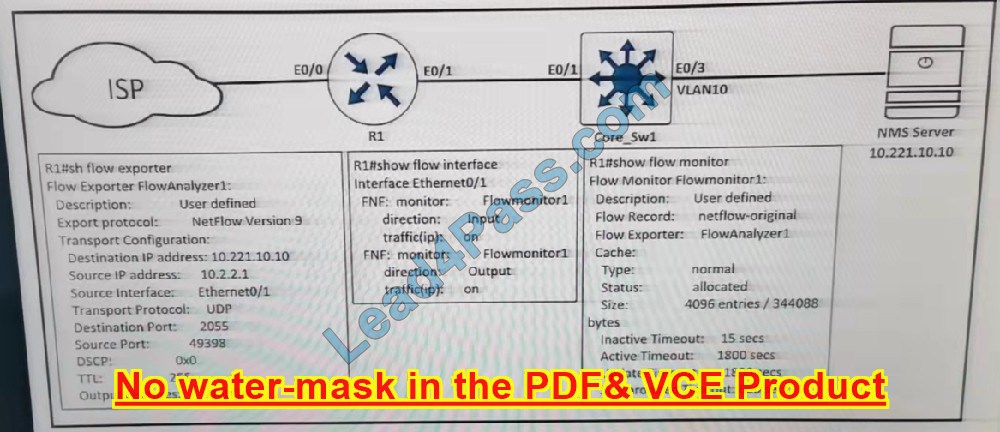
An engineer configured NetFlow on R1, but the NMS server cannot see the flow from ethernet0/0 of R1.
Which configuration resolves the issue?
A. flow monitor Flowmonitor1 source Ethernet0/0
B. interface Ethernet0/1 ip flow monitor Flowmonitor1 input ip flow monitor Flowmonitor1 output
C. interface Ethernet0/0 ip flow monitor Flowmonitor1 input ip flow monitor Flowmonitor1 output
D. flow exporter FlowAnalyzer1 source Ethernet0/0
Correct Answer: C
Question 24:
Refer to the exhibit.
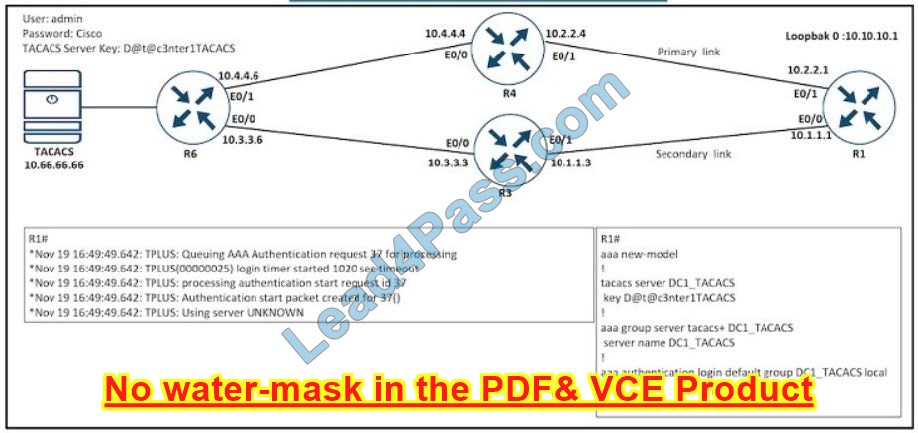
Refer to the exhibit R1 cannot authenticate via TACACS Which configuration resolves the issue?
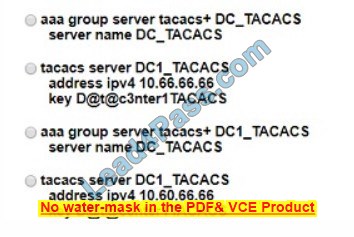
A. Option A
B. Option B
C. Option C
D. Option D
Correct Answer: B
Question 25:
Examine the following diagram:
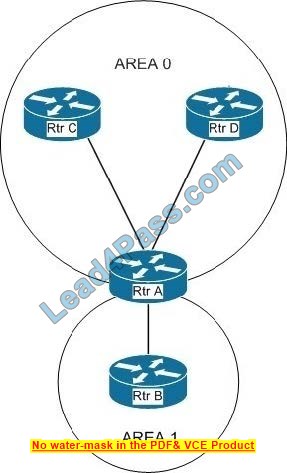
Which of the following actions will make Area 1 a totally stubby area? (Choose all that apply. Each correct answer is part of the solution.)
A. execute the area 1 stub no-summary command on RouterA
B. execute the area 1 stub no-summary command on RouterB
C. execute the area 1 stub command on RouterB
D. execute the area 1 stub command on RouterA
E. execute the area 0 stub-no summary command on RouterA
F. execute the area 0 stub no-summary command on RouterB
G. execute the area 0 stub command on RouterB
H. execute the area 0 stub command on RouterA
Correct Answer: AC
You should execute the area 1 stub no-summary command on RouterA and the area 1 stub command on RouterB. A totally stubby area is one that only keeps local area routes in the link-state database (LSDB), plus a default route that leads
out of the area. To make an area totally stubby, the area border router (ABR) should be configured with the area 1 stub no-summary command and all other area routers should be configured with the area 1 stub command. The diagram in the
scenario indicates that RouterA is the border router. You should not run any of the commands that refer to area 0. This would affect a different area than the requirement stated in the scenario.
None of the other combinations of actions will create a totally stubby area.
If you run the area 1 stub command on both RouterA and RouterB, it will create a stub area. A stub area differs from a totally stubby area in that a stub area will allow updates about areas in the same OSPF domain.
Objective:
Layer 3 Technologies
Sub-Objective:
Configure and verify network types, area types, and router types
References:
Cisco > Home > Support > Technology Support > IP > IP Routing > Design > Design Technotes > What Are OSPF Areas and Virtual Links? > Define a Totally Stub Area
Question 26:
Refer to the exhibit. The output of the traceroute from R5 shows a loop in the network. Which configuration prevents this loop?
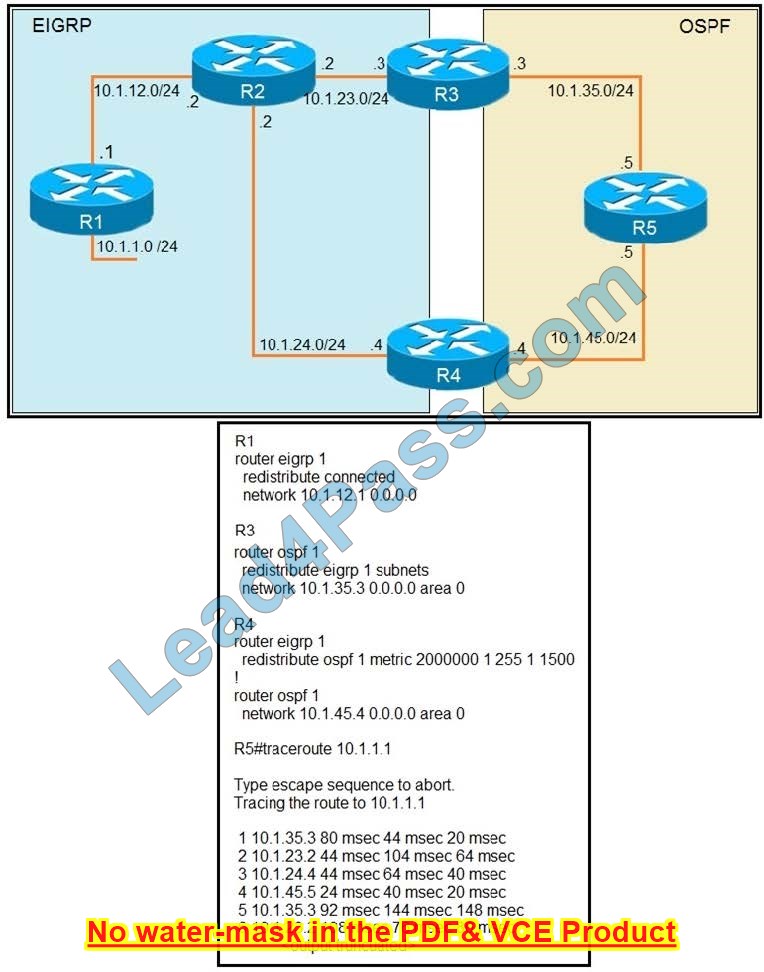
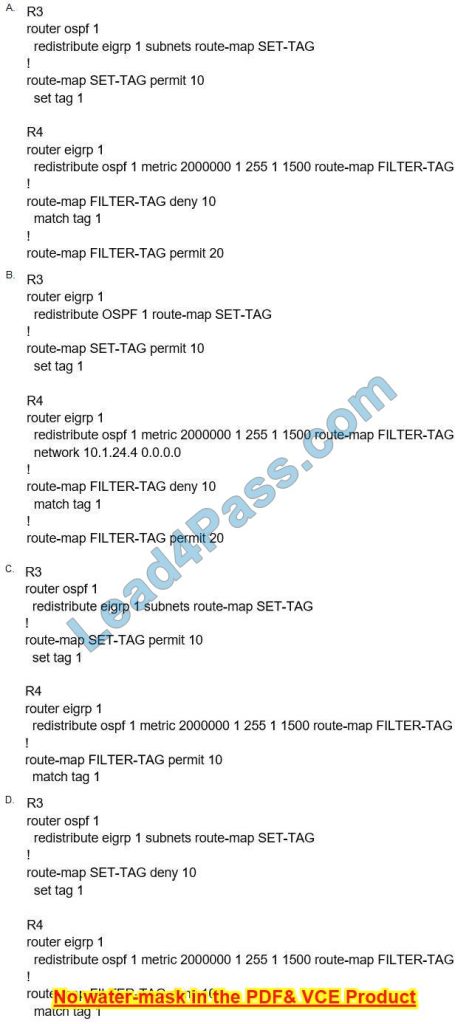
A. Option A
B. Option B
C. Option C
D. Option D
Correct Answer: A
Question 27:
Your company has a policy of creating all configurations in text files, checking the files, and then applying the configurations to the devices. Your assistant has presented you with the following partial configuration that she plans to execute on a router:
interface S0/0/1 ipv6 address 2001:610:FFFF:1::1/64 ipv6 ospf 100 area 0
ipv6 router ospf 100 router-id 10.1.1.6 The configuration is supposed to accomplish the following: Enable IPv6 routing Assign a router ID Assign an IPv6 address to the interface Place the interface in OSPF area 0
Which step does this configuration NOT complete?
A. Enable IPv6 routing
B. Assign a router ID
C. Assign an IPv6 address to the interface
D. Place the interface in OSPF area 0
Correct Answer: A
The configuration indicates all steps are complete except for globally enabling IPv6 routing. If that had been done, the configuration output would have reflected it under the interface as follows:
interface S0/0/1 ipv6 address 2001:610:FFFF:1::1/64 ipv6 ospf 100 area 0 ipv6 enable ipv6 router ospf 100 router-id 10.1.1.6
Prior to configuring OSPFv3 on an interface, it must be enabled globally. OSPFv3 is an OSPF version specific to IPv6. The following commands will globally enable OSPF v3. It will then be reflected by the ipv6 enable statement under the interface when viewing the configuration as shown in the fourth line of the output above.
Router5(config)# ipv6 unicast-routing Router5(config)# ipv6 ospf 100 Router5(config-rtr)# router-id 10.1.1.6
The problem is not the router ID. The configuration in the scenario does assign a router ID, as indicated by these lines:
ipv6 router ospf 100
router-id 10.1.1.6
The problem is not the IPv6 address. The configuration does assign an IPv6 address to the interface, as indicated by these lines:
interface S0/0/1
ipv6 address2001:610:FFFF:1::1/64
OSPF area 0 is not the problem. The configuration does place the interface in OSPF area 0, as indicated by these lines:
interface S0/0/1
ipv6 ospf 100 area 0
Objective:
Layer 3 Technologies
Sub-Objective:
Configure and verify OSPF for IPv6
References:
Cisco > Implementing OSPF for IPv6 > How to Implement OSPF for IPv6
Question 28:
The network administrator is tasked to configure R1 to authenticate telnet connections based on Cisco ISE using RADIUS. ISE has been configured with an IP address of 192.168.1.5 and with a network device pointing towards R1
(192.168.1.1) with a shared secret password of Cisco123. If ISE is down, the administrator should be able to connect using the local database with a username and password combination of admin/cisco123.
The administrator has configured the following on R1:
aaa new-model! username admin password cisco123! radius-server ISE1
address ipv4 192.168.1.5
key Cisco123 ! aaa group server tacacs+ RAD-SERV
server name ISE1 ! aaa authentication login RAD-LOCAL group RAD-SERV ISE has gone down. The Network Administrator was not able to Telnet to R1 when ISE went down. Which two configuration changes will fix the issue? (Choose two.)
A. aaa authentication login RAD-SERV group RAD-LOCAL local
B. aaa authentication login RAD-LOCAL group RAD-SERV local
C. line vty 0 4 login authentication RAD-LOCAL
D. line vty 0 4 login authentication default
E. line vty 0 4 login authentication RAD-SERV
Correct Answer: BC
Question 29:
Refer to the exhibit. The network engineer configured the summarization of the RIP routes into the OSPF domain on R5 but still sees four different 172.16.0.0/24 networks on R4. Which action resolves the issue?
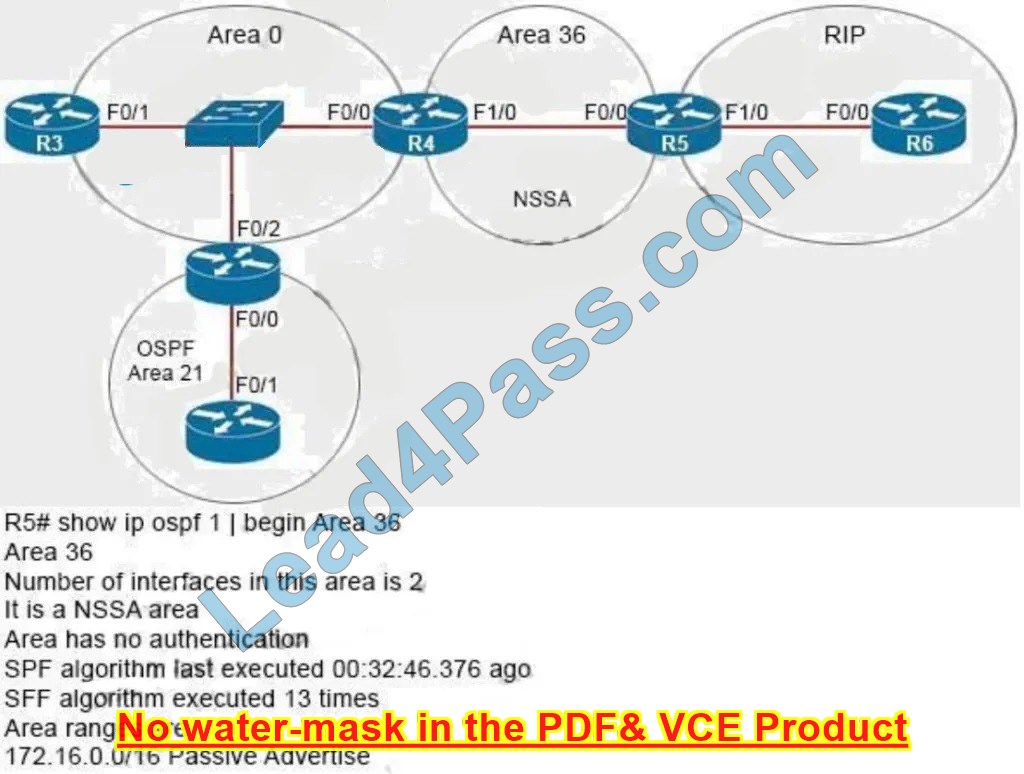
A. R5(config)#router ospf 1 R5(config-router)#no area R5(config-router)#summary-address 172.16.0.0 255.255.252.0
B. R4(config)#router ospf 99 R4(config-router)#network 172.16.0.0 0.255.255.255 area 56 R4(config-router)#area 56 range 172.16.0.0 255,255.255.0
C. R4(config)#router ospf 1 R4(config-router)#no area R4(config-router)#summary-address 172.16.0.0 255.255.252.0
D. R5(config)#router ospf 99 R5(config-router)#network 172.16.0.0 0.255.255.255 area 56 R5(config-router)#area 56 range 172.16.0.0 255.255.255.0
Correct Answer: A
Area 36 is an NSSA so R5 is an ASBR so we can summarize external routes using the “summaryaddress” command. The command “area area-id range” can only be used on ABR so it is not correct. The summarization must be done on the
ASBR which is R5, not R4 so the correct answer must be started with “R5(config)#router ospf 1”.
Note: The “no area” command is used to remove any existing “area …” command (maybe the “area 56 range …” command).
Question 30:
Refer to the exhibit.
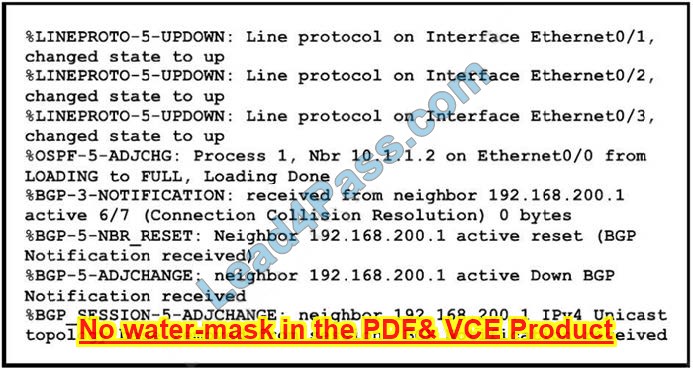
An engineer noticed that the router log messages do not have any information about when the event occurred. Which action should the engineer take when enabling service time stamps to improve the logging functionality at a granular level?
A. Configure the debug uptime option.
B. Configure the msec option.
C. Configure the timezone option.
D. Configure the log uptime option.
Correct Answer: B
Practice the latest 300-410 Dumps exam questions online to help you learn more about the latest CCNP Enterprise 300-410 certification exam trends! And help you improve your professional skills!
Use CCNP Enterprise 300-410 Exam Solutions: Download Latest 300-410 dumps: https://www.leads4pass.com/300-410.html (PDF+VCE), to help you pass the exam 100% successfully.